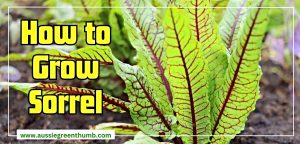When you think succulents, you probably think low maintenance, and you would be right. In Australia, succulents have become more popular as people want gardens that aren’t affected by drought.
When the temperatures rise and the water threatens to run out due to lack of rainfall, these plants manage to keep their cool. Succulents are even fire-resistant!
Read on to learn more about succulent plants and which are the most grown types in Australia.
More...
You’ll find succulent plants in both dry and wetter, more tropical parts of Australia, proving they are adaptable and eager to please. Succulents are able to grow on trees and rocks if that’s where they find the right habitat.
Australia boasts at least 400 species of succulent. What’s nifty about these plants is that they have their own built systems for storing water in their leaves, stems or roots.
Adding greenery to your home décor is a great way to style your table. Australian succulents are perfect for this purpose, as they require little maintenance.
Succulents are available in various shapes and sizes, so you can find one that fits your style. They also come in multiple colors, deep green and vibrant pink.
Australian succulents are an excellent addition to your table setting and will impress guests.
Best Succulents to Grow in Australia
Aeonium Succulents
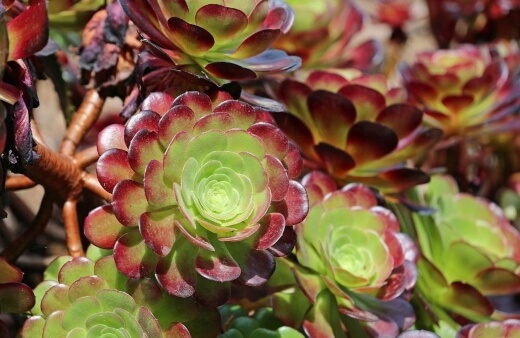
Aeonium succulents are a bit different than other succulents. Most will grow on a short stem but Aeoniums grow like a tree. They have a main stem and then branches that grow numerous rosettes.
Winter is their active growing period. This means you want to fertilise in early winter and not when the succulents are dormant in summer. A fertiliser with a limited amount of nitrogen is best.
You can plant Aeoniums directly into the garden – just a heads up, they like sandy loam soil and it should be fast draining.
Aeoniums are dormant in summer – this means you can take a break from watering them all together or limit their water substantially. If your summer is very hot, perhaps give the succulent a sprinkling of water once a week.
Make sure your plant gets morning sun in the winter time – 6 hours is ideal. You’ll notice in winter that the stems are soft and green. In summer, the leaves will close up and start to fall off.
Here are some popular aeoniums:


Get Your Free Guide:
Master Growing Australian Natives eBook
A Must Have Complete Guide for Every Australian Garden
Get Your Free Guide:
Master Growing Australian Natives eBook
A Must Have Complete Guide for Every Australian Garden
Aeonium lindleyi

Source: plantingman.com
This species has small rosettes but it can grow up to 50cm in height. The leaves are hairy and sticky. The flowers arrive in late spring and have a yellow star shape.
Aeonium ‘Starburst’ or ‘Lemon and Lime’
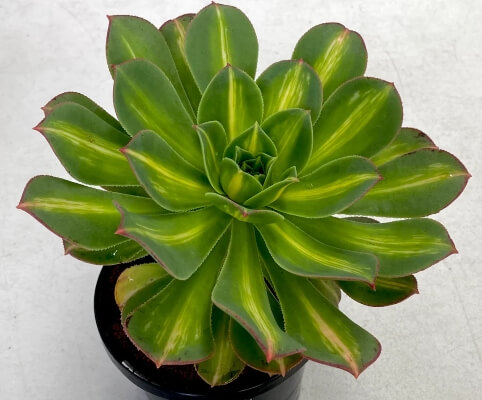
Source: mld-succulents.com
They are huge with a 50cm diameter. The leaves have lemon yellow stripes which explains the name.
Aeonium ‘Mardi Gras’
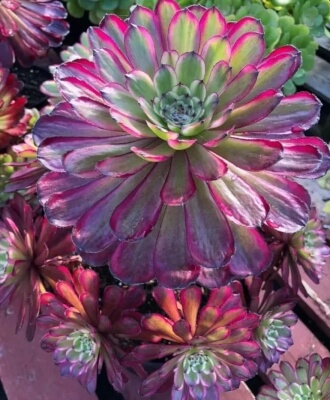
Source: succulentcity.com
This cultivar earned its name thanks to the colourful leaves that create quite a spectacular display.
Aeonium ‘Velour’ (Hybrid)
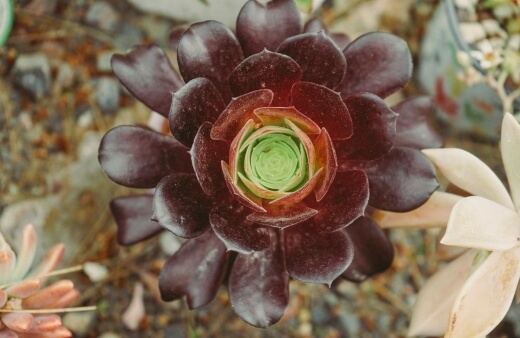
This hybrid is muted in winter when it’s green with red edges on the leaves. Closer to spring, the red colour gets darker and takes over more of the leaves.
Aeonium ‘Blushing Beauty’

This succulent grows more like a tree. In winter, the succulent is green with red or pink on the leaf edges. The colours get bolder closer to summer.
Aeonium sedifolium
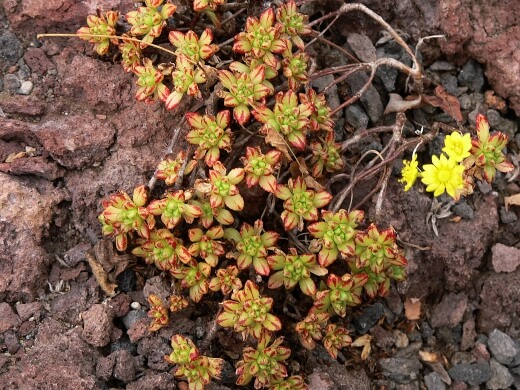
Source: en.wikipedia.org
Dwarf aeonium packs a punch even though it’s small. It only grows 15cm tall and wide, with round green leaves that have red on them.
Agave Succulents

The Agave group of succulent plants have more than 300 species and is one of the most searched australian succulents. You could call them aggressive looking perhaps, or maybe ready for battle.
The leaves look a bit like swords, with sharp teeth on the edge of the leaves and spines on the leaf tips. It’s certainly a ‘don’t mess with me’ kind of plant.
These succulents flower but you might end up waiting a long time – it can take up to 40 years, species dependant. On the plus side, these succulents are not difficult to grow. If you give them full sun and well-drained soil, you’re good to go.
Small agave succulent plants grow perfectly in pots – maybe just make sure they aren’t placed near any pets (or children for that matter).
Here’s something you might not know. Agave succulents are actually considered weeds in NSW and Victoria (well they have the potential to become weeds) so do some research before you start planting.
Here are a few popular agaves:
Agave americana
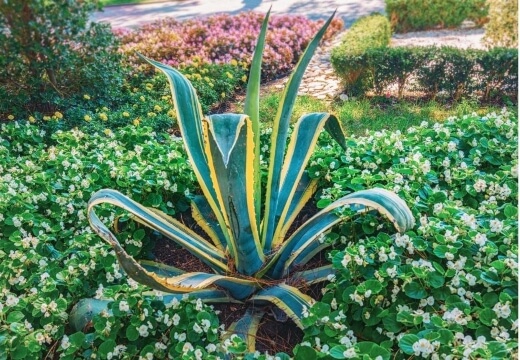
This species is grey and has sharp leaves. The succulent also forms a rosette shape. You might hear it called the century plant because of an old belief that the succulent only flowers every 100 years!
The plant has yellow flowers and there are a few varieties available. They include Marginata which has yellow stripes on the side of the leaves, Medio-picta’ with a thick yellow stripe down the middle, and Striata.
Agave angustifolia
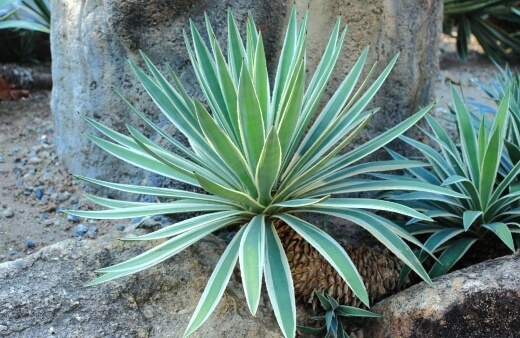
This succulent loves the heat. This rosette succulent has green to yellow flowers and some varieties have white stripes on the leaves.
Agave attenuata

Agave attenuata is also called fox tail agave. Rosette shaped with green to blue leaves, the flowers are yellow and drooping.
Agave victoriae-reginae

Queen Victoria agave grows very slowly. The thick leaves have a white stripe and a sharp spine at the tip. The flowers are a light green to cream colour.
Aloe Succulents
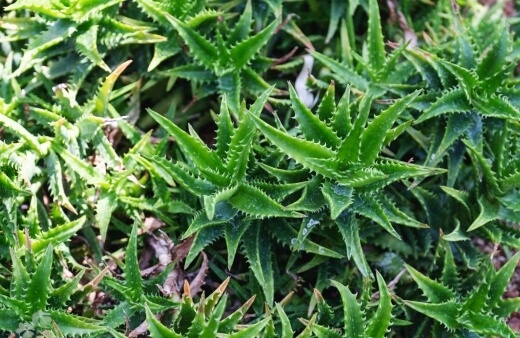
Aloe succulents probably come in every shape and colour you could imagine, not to mention a varied size curve. Aloes are easy to grow, even though it might not be your first choice when browsing through your local nursery.
These succulent plants can handle tough climates – their solution is to store water and food in their leaves and roots. Aloe flowers are quite a sight to see in shades of yellow, orange and red. They actually flower for most of the year.
Succulents like aloes often do well in rockeries and a rock garden can look great while being low maintenance at the same time. If you feel inspired to set up your own, have a look at our guide on how to set up a rock garden
Here are some popular aloes:
Aloe Andrea’s Orange

Source: thetutuguru.com.au
This is a hybrid aloe that has a long flowering period with bright orange tubular flowers.
Aloe Aries
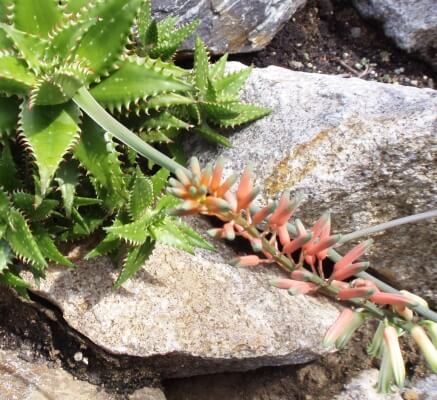
Source: aloe-aloe.com.au
This aloe has short and spotty leaves which is what makes the plant beautiful more than the pink-white flowers it produces. The flowers actually open at different times across the seasons which makes for a nice surprise.
Aloe Bush Baby Yellow
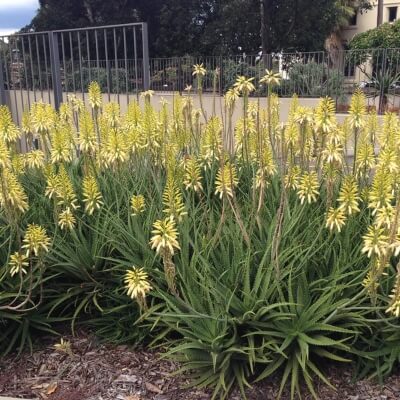
Source: diggers.com.au
This aloe has lots of rosettes and can flower for up to 6 months. It does well in the garden or in a pot.
Aloe Fairy Pink
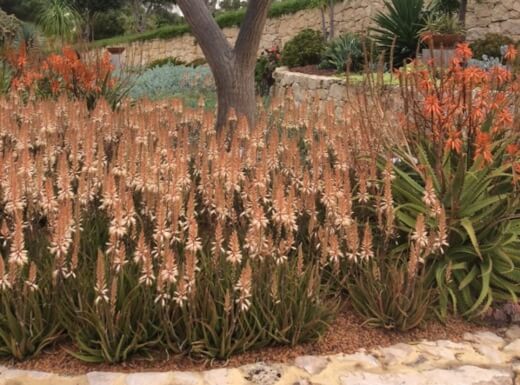
Source: aloe-aloe.com.au
The word ‘fairy’ in the name is apt for the dainty white flowers and delicate leaves of this small aloe. For a tropical climate, it grows better in a pot.
Aloe Ivory Dawn

Source: agaveville.org
This is an aloe that is extremely generous with its flowers. It produces flowers sometimes up to 12 months in a row, with repeat blooms following each other. The flowers are a red pink colour and sometimes closer to white.
Aloe Mountain Gem
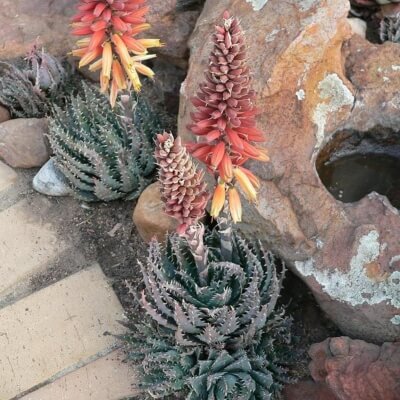
Source: flowerpower.com.au
You’ll find red to cream colour flowers on this aloe which arrive in winter. The leaves are blue-grey and have white lines on them. This particular aloe needs lots of light to produce flowers.
Aloe Sparkler

Source: thetutuguru.com.au
If you want flowers, flowers and more flowers, this aloe is a great choice as it flowers from autumn into winter. The white flowers, once opened, show off orange and yellow colours.
Aloe Super Red
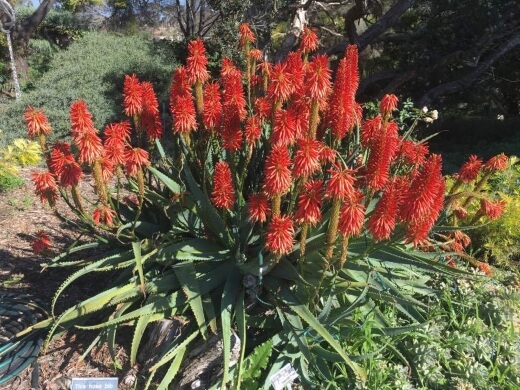
Source: davesgarden.com
This succulent produces red flowers from late summer to winter and is a greyish-green colour. It can handle a harsh landscape.
Aloe Winter Bells

Source: aloe-aloe.com.au
This succulent has thin dark green leaves, a red trim with white bell-shaped flowers in autumn and winter.
Echeveria Succulents

Echeveria succulents are easy going but live in some crazy conditions. These succulent plants range from desert to subtropical and their idea of home is a high altitude cliff or rock face.
Extreme weather conditions don’t phase these succulents. Echeveria succulents need soil that drains well and enough air around them to breathe.
They can handle drought so well that if you forget to water them for a while they won't die! This means in autumn and winter you can water once a month and that’s enough.
Echeveria succulents can suffer from root rot – this means no waterlogged soil. Succulents can handle the cold better if their roots are dry. Nobody likes wet feet and these succulent plants are the same.
When in doubt, rather don’t water. The truth is, Echeveria succulents die much quicker from over watering than if you under water them. Refer to our guide how to grow and care for Echeveria for more information on this type of succulent.
Here are some popular echeverias:
Echeveria affinis ‘Black Knight’
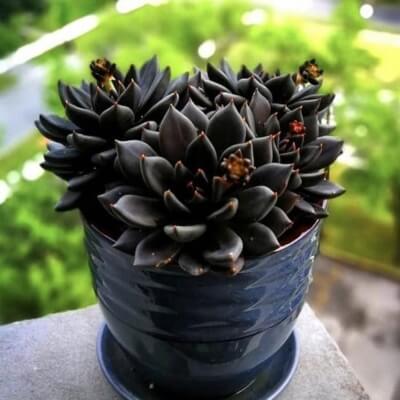
Source: botanyheaven.com
This cultivar has leaves that are closely packed together to form a rosette. It has dark red flowers in summer and is easy to grow.
Echeveria ‘Dondo’
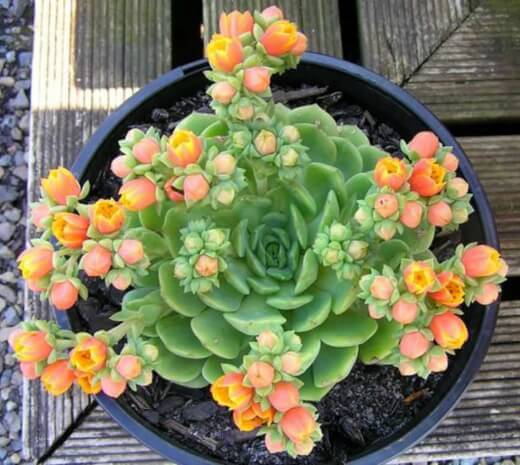
Source: worldofsucculents.com
This plant makes you think of sunshine. The succulent has orange flowers and bright green leaves.
Echeveria ‘Dark Prince’
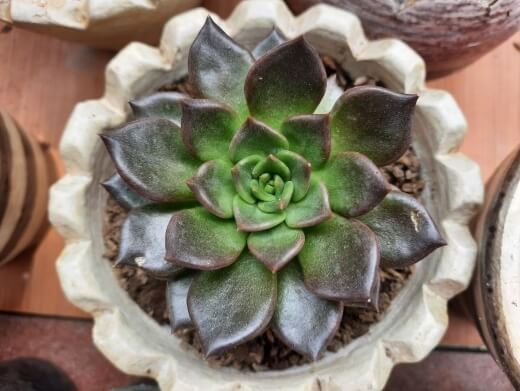
This Echeveria variety has leaves that look almost black. They are in fact a dark purple colour.
Echeveria ‘Raindrops’

Source: gardentags.com
Echeveria 'Raindrops’ are small with rosettes of green leaves with red. There is a blue-green bump in the middle of each leaf which looks a bit like a water droplet.
Echeveria peacockii
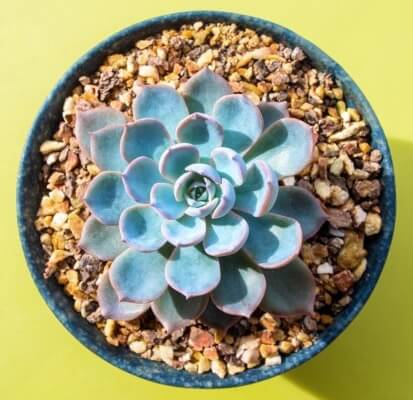
This species is small and has blue leaves with red tips. The leaves are round and it produces bright orange flowers in summer.
Echeveria ‘Imbricata’
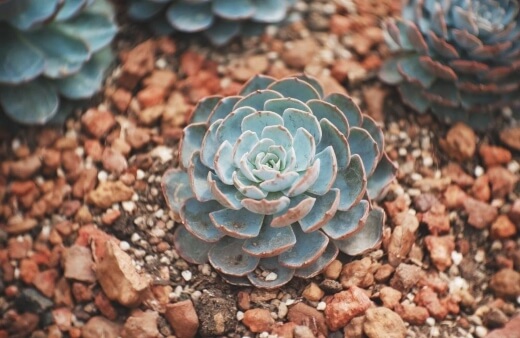
Known as Blue Rose Echeveria, grows fast and you’ll recognize it by rosettes of round blue green leaves, which overlap in a circular pattern.
Echeveria derenbergii

Echeveria derenbergii has small rosettes of triangle-shaped blue-grey leaves with red outlines. In late winter and summer, the succulent has reddish pink stems and yellow flowers.
Sempervivum Succulents
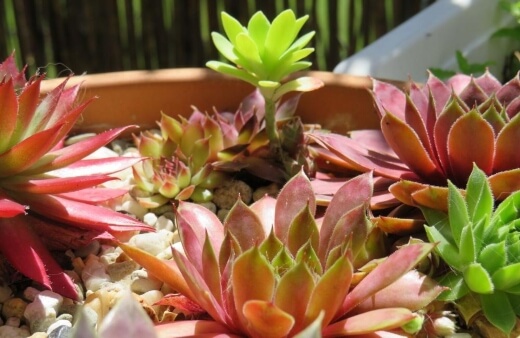
Sempervivum is also called hen and chicks and it creates a mat effect as it grows. This genus of about 40 species are known for plants with rosette patterns.
The leaves are thick and pointed but some are more round. The succulents are a whole host of different colours – everything from green to pink and purple.
What’s amazing is that the colours can change throughout the seasons. This happens when temperatures change or when the habitat of the plant changes.
This type of succulents have small white or yellow flowers in the summer. You might be wondering where Sempervivum gets its name hen and chicks from. Imagine that the hen is the large rosette and the chicks are the new growth that it produces.
When the hen eventually dies, the chicks keep growing and keep the plant alive. These succulent plants can be used in pots or in the garden. It might even look nice in a hanging basket.
Again you’ll need well-draining soil and plant your succulent in full sun. As a rule of thumb, you can water when the soil feels dry. You want the succulent to actually dry out between watering.
Another tip for this type of succulents is to water around the rosettes without throwing water onto them.
Here are some popular sempervivums:
Sempervivum ‘Appletini’
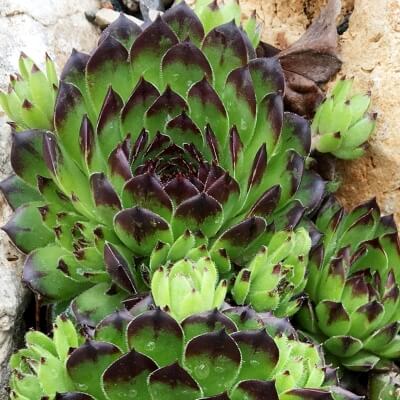
Source: gardenersdream.co.uk
This Sempervivum cultivar has pointy green leaves with red to brown tips. The colour of the succulent actually gets darker as the plant gets more light.
Sempervivum Cherry Berry
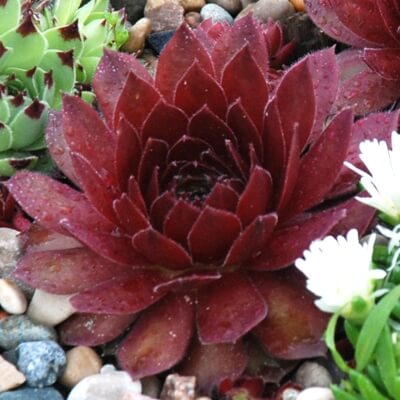
Source: gardenersdream.co.uk
This plant forms a rosette that starts off green with a red centre and then becomes a darker red rosette when the weather becomes warmer.
Sempervivum Silver Suede
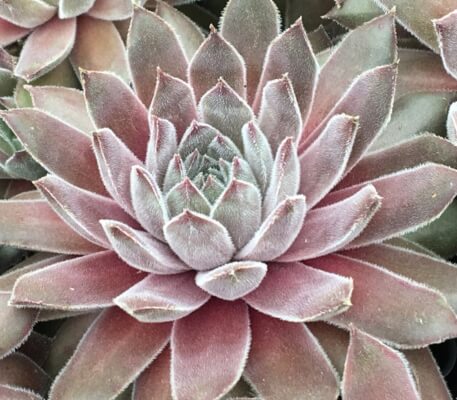
Source: gardensolutionsplants.com
Sempervivum Silver Suede is covered with a fine fuzz. The blue-green rosettes are red and mauve in the cooler months.
Succulents Frequently Asked Questions
Do succulents need sun or shade?
‘Succulents’ is a wide-reaching name, used to describe any plant that stores water in its leaves, from tropical to mountain-side plants. Most succulents do best in bright, indirect light, but there are many species and genera that prefer full sun, or even shade.
How often do you water a succulent?
Succulents are adapted to store water, so need watering less than most types of plants. While their soil may dry out faster than other plants, it’s important to let them drain fully before watering again.
In some homes that might be twice a week, in others, it might be once a month.
Do my succulents need bigger pots?
Succulents have fibrous roots, which quickly spread through the soil, and are typically twice the width of the plant itself. In most species, this adaptation lets them reach deep into rocky outcrops for moisture.
If your succulent leaves are within 2cm of the side of their pot, they should be repotted into new compost, and in a new pot.
How do you know if a succulent needs water?
There are two ways to know if your succulent needs water; 1, soil; 2, leaves. If the soil around the base of your succulent is completely dry, it’s definitely time to water.
The best time to water them is when the top inch of soil is dry, but the base of the container still has a little moisture left. If the leaves of your succulent are wrinkled or curled in, stand its pot in a tray or water for half an hour until the soil has soaked up everything it can.
How long do indoor succulents live?
Indoor succulents are surprisingly short lived, with most species only surviving for 3 to 4 years. However, healthy succulents will send out pups to replace themselves.
Ideally, a neatly mounded display of succulents, made up of several plants will live forever in your home. It’s all about managing moisture and nutrients, and removing parent plants when their offspring start to outcompete them.
Can you leave succulents out all year round?
Many forms of succulents, like sedum, are happiest outdoors, and should be left outside through rain, frost, and baking summers. Some Mediterranean succulents, while cold hardy, are not damp hardy, so will suffer if left in the garden over a wet winter.
Is it better to water succulents from the top or bottom?
Like most things in horticulture, water is better than no water for dry plants. However, if you want to maintain the health of your succulents, watering them from the bottom is definitely better.
They won’t be splashed by the soil, and their pots have a chance to soak up everything they need, without getting too wet, or leeching out nutrients.
How long can succulents go without water?
Succulents are perfect plants, indoors and out, for any gardener who spends a lot of time away from home, as they can survive without water for up to three months.
The main adaptation of succulents is water storage, so there’s no need to worry about your succulents while you’re away, as long as you fed and watered them before you left!
What to do with succulent leaves that fall off?
If your succulent has dropped its leaf, don’t worry too much. It’s likely due to overwatering or age. Take the leaf and leave it to dry out (callous) for a few days. Once the end has dried off, place it flats on the surface of loose compost.
Mist the compost every couple of days to retain moisture, and the leaf should root within two weeks, creating tiny new plants.
Should succulents be in soil or rocks?
Succulents need free-draining soil, and can grow in pretty much any substrate, provided there is some water available. In pots with a reservoir, succulents can be grown in pure grit, but it’s best to mix grit and compost together at a roughly 50/50 ratio.
Why put rocks on top of succulents?
A generous mulch of gravel, grit, or pea gravel is ideal for succulents because it prevents water from splashing back onto their leaves (useful for disease prevention, and appurtenance).
A mulch of rocks in any form will also help to retain heat and moisture in the soil, particularly for succulents planted in full sun.
How do I know if my succulent is happy?
If your succulent is happy, it will develop new plants around its edge, called pups. These can either be left in place for a gorgeous mounded effect or replanted separately to add to your collection of houseplants.
Happy succulents have plum, moisture-filled leaves, and will stay that way after a few days in dry soil.
Succulents not included in the list above but are also sought-for in Australia are the Mother in law's tongue and Australian pig face so be sure to check them out.
Why not sign up for our newsletter for more gardening inspiration and tips, resources and plant profiles. It’s the perfect reading to enjoy with a cup of tea and whether you’re a beginner gardener, or have spent much time perfecting your green thumb, there really is something for everyone.
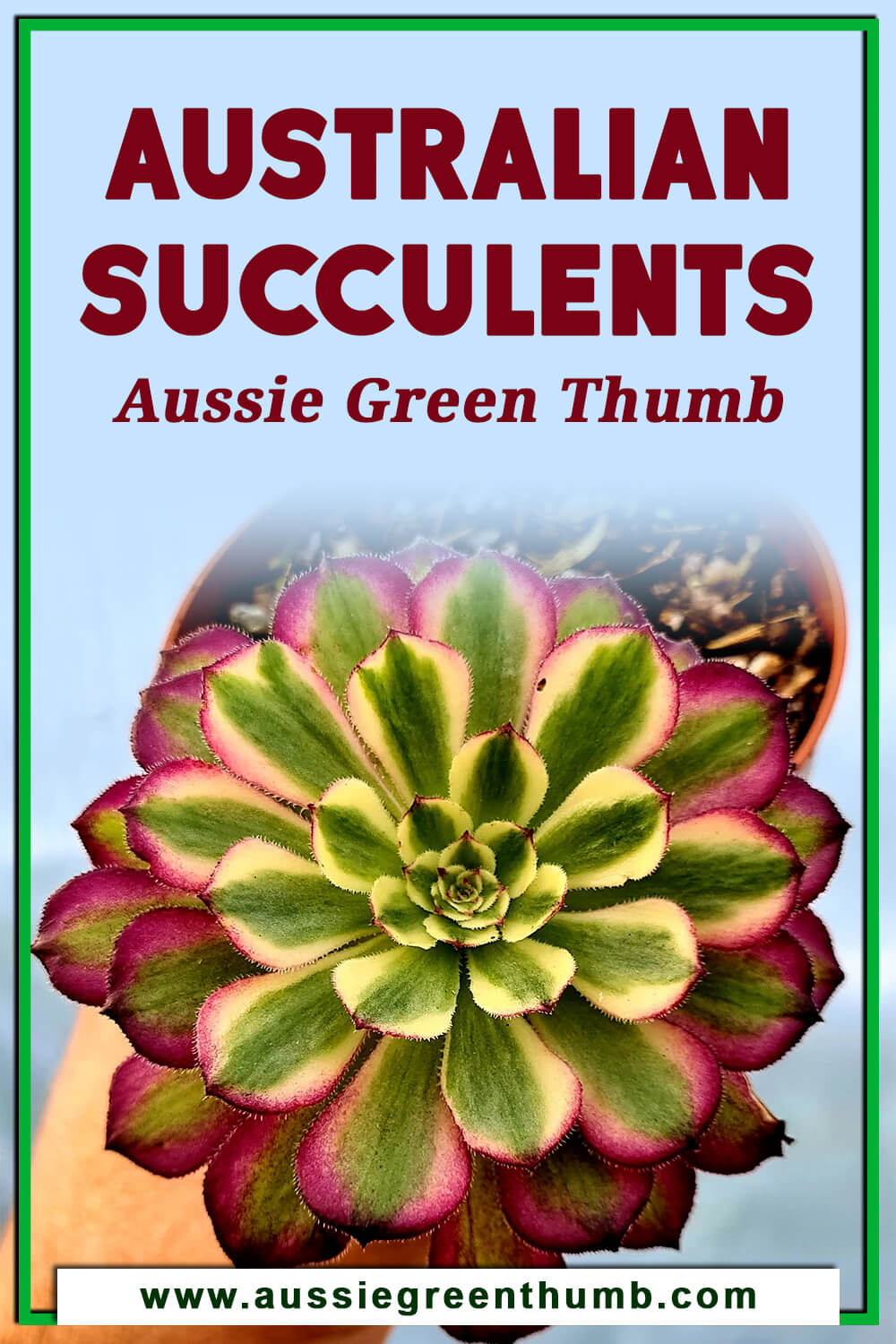
Welcome to the World of Succulents
Australia is home to a wonderful variety of succulents and as we’re discovered, they don’t ask for a lot in exchange for gorgeous flowers and brilliant floral displays.
With the stress of keeping a plant happily watered off the table (since these beauties are not too thirsty), you can just enjoy growing and decorating with them.
Whether potted or in a garden bed or xeriscape (or rockery once you’ve read our ‘how to’ guide, our country has a range of succulents to keep every gardener and home happy.
Published on January 18, 2023 by Nathan Schwartz
Last Updated on September 20, 2024




